The Intersection of Yoga and Women’s Health
Yoga, an ancient practice with origins tracing back to India, transcends mere physical activity, offering holistic benefits that cater to the mental, emotional, and physical facets of health. For women, in particular, yoga serves not just as a refuge for stress relief but also as a powerful tool for addressing various health concerns specific to female physiology. The intersection of yoga and women’s health is a subject of increasing interest within the medical community, recognizing yoga’s potential in mitigating issues ranging from menstrual discomfort to the challenges of menopause.
Empirical research underscores yoga’s role in bolstering women’s health, primarily through its capacity to regulate hormonal imbalances, enhance mood, and strengthen the musculoskeletal system. As practitioners navigate through poses, or asanas, they stimulate different bodily systems, promoting increased blood circulation, better endocrine function, and improved digestive health. Stress, a known exacerbator of many health ailments, stands significantly reduced courtesy of yoga’s emphasis on breath control and meditation.
The selection of yoga poses is critical in addressing specific health concerns. Certain asanas can be particularly beneficial for women, focusing on areas like pelvic floor strength, hormone regulation, and overall well-being. Women of all ages and stages of life can adapt these poses to fit their needs, making yoga an inclusive practice.
For optimal women’s health, a tailored approach that incorporates essential yoga poses can provide a multitude of benefits. With regular practice, yoga can enhance quality of life and contribute fundamentally to women’s physical and emotional health.
The Holistic Benefits of Yoga for Female Well-Being
Yoga, an ancient practice with a rich history rooted in improving overall health, offers a diverse array of physiological, psychological, and emotional benefits particularly advantageous to women. It’s a comprehensive tool for maintaining and improving female well-being, embracing a holistic approach that nurtures the body, mind, and spirit.
- Physical Health: Regular yoga practice strengthens muscles, increases flexibility, and improves posture, which is vital for women who may experience back pain due to various reasons including long hours of sitting or after giving birth. Additionally, certain yoga poses are known to enhance reproductive health and alleviate symptoms associated with menstrual discomfort and menopause.
- Balance Hormones: Yoga’s stress-relieving properties can help regulate hormonal imbalances, a common concern for women at various stages of life. Through breathwork and relaxation techniques, yoga assists in reducing cortisol levels, potentially mitigating the impact of stress on menstrual cycles and fertility.
- Mental Clarity: Engaging in yoga cultivates mindfulness and can lead to enhanced focus and mental clarity. Asanas paired with meditation encourage a state of presence, contributing to reduced anxiety and depression rates, conditions that women disproportionately face.
- Emotional Resilience: The introspective and meditative aspects of yoga support emotional stability. By fostering a sense of inner peace and resilience, yoga helps in navigating life’s challenges and promotes a positive outlook on life.
- Community and Support: Yoga often brings people together, offering a sense of community that is especially beneficial for women seeking connection and support. Group classes provide an environment to share experiences and find common ground with others.
The practice of yoga is adaptable to individual needs, making it accessible to women of all ages and walks of life. Embracing yoga can lead to substantial improvements in health and well-being, solidifying its role as a powerful tool for female empowerment.
Pose 1: Mountain Pose (Tadasana) – Foundation for Postural Integrity
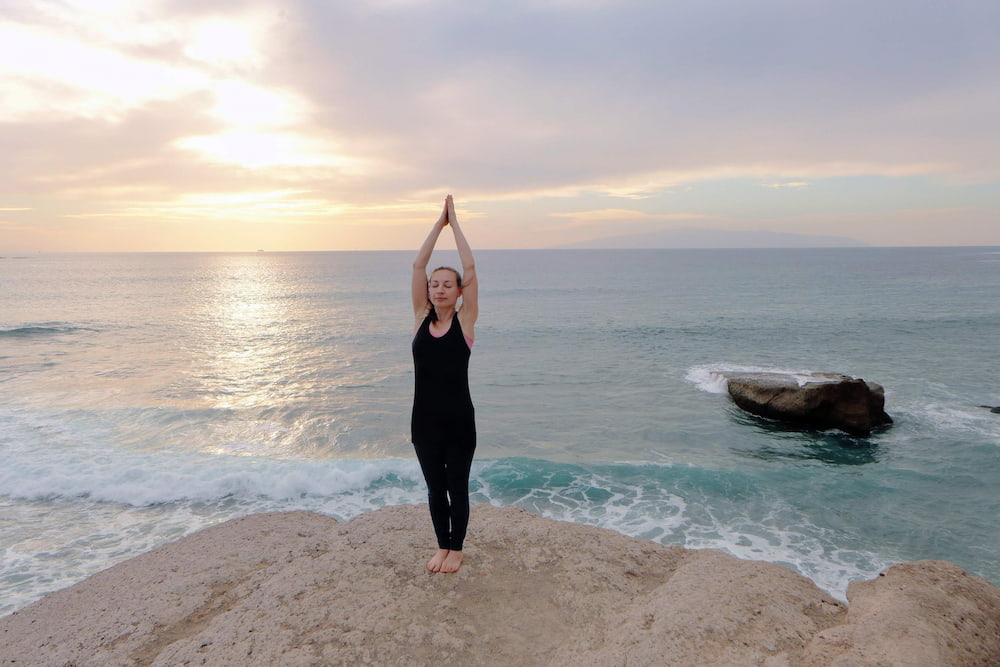
The Mountain Pose, or Tadasana, is a foundation yoga pose that promotes postural integrity and has significant benefits for women’s health. Tadasana is deceptively simple yet powerful; it involves standing with feet together, grounding evenly through the soles, and lifting the crown of the head towards the sky to align the spine.
To perform Tadasana:
- Stand with feet hip-width apart, spreading the toes wide to distribute weight evenly.
- Engage the quadriceps to lift the kneecaps and firm the thighs.
- Gently draw the belly in to engage the core muscles.
- Allow the arms to hang naturally with palms facing forward, which opens the chest and encourages better breathing.
- Lengthen the neck as if a string is pulling the crown of the head up.
- Maintain a neutral pelvis, avoiding excessive tucking or arching.
- Focus on deep, even breaths to center the mind and increase oxygen flow.
Regular practice of the Mountain Pose can enhance stability and balance, strengthen the thighs and knees, and reduce flat feet. For women, Tadasana is particularly beneficial in developing core strength and pelvic floor stability, which are essential for supporting reproductive organs and may aid in menstrual cycle regulation.
Moreover, this pose teaches body awareness, allowing women to stand with poise and confidence. As it corrects posture, Tadasana can also relieve back pain, which is common in women due to various factors such as high heels or carrying children. Engaging in Tadasana daily provides a moment of stillness and grounding, which promotes mental calmness and can be especially supportive during hormonal fluctuations.
Pose 2: Downward Facing Dog (Adho Mukha Svanasana) – Full Body Rejuvenation
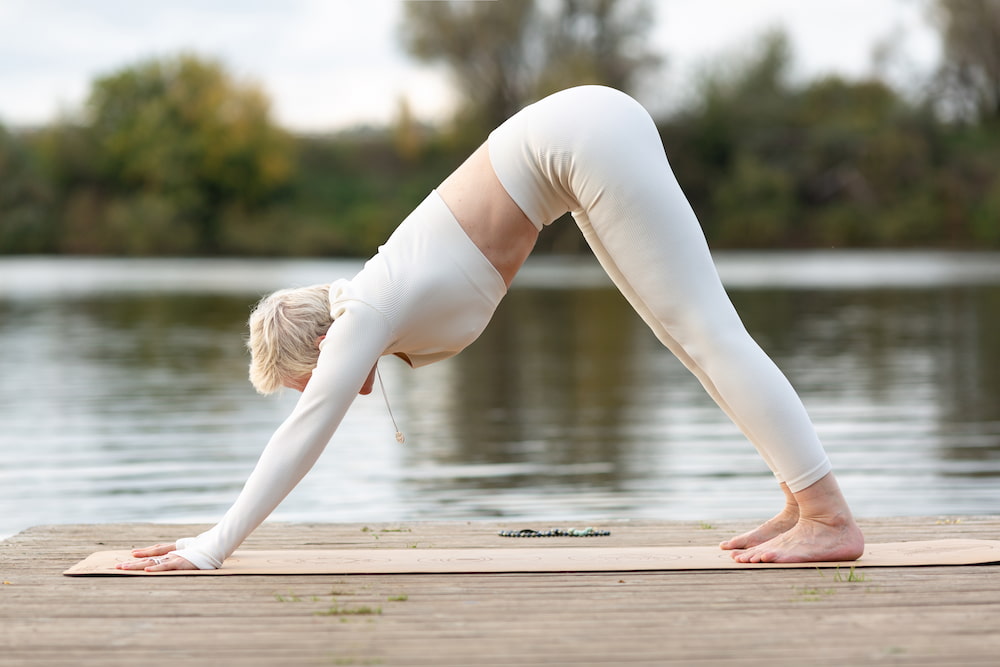
Downward Facing Dog, known in Sanskrit as Adho Mukha Svanasana, is a quintessential yoga pose that offers extensive benefits for women’s health, engaging multiple muscle groups and increasing overall body strength. Here is a step-by-step guide to help in properly executing the Downward Facing Dog:
- Begin on your hands and knees, with your wrists aligned under your shoulders and your knees under your hips.
- Spread your fingers wide and press firmly through your palms and knuckles.
- Exhale as you tuck your toes and lift your hips up and back, extending your legs to bring your body into an inverted V-shape.
- Keep a slight bend in your knees if necessary, especially if you have tight hamstrings.
- Make sure your feet are hip-width apart, and your toes are pointing forward.
- Press your hands into the ground, lengthen your spine and tailbone, and engage your abdominal muscles.
- Let your head hang freely, and ensure your ears are in line with your upper arms.
- Hold the pose for 30 seconds to one minute, breathing deeply and evenly.
Adho Mukha Svanasana is an all-encompassing pose that strengthens the arms and legs while stretching the hamstrings, calves, shoulders, and hands. It helps improve circulation by reversing blood flow, and it also invigorates the nervous system, increasing energy levels. As a weight-bearing exercise, it helps build bone density, which is crucial for preventing osteoporosis. Additionally, this pose aids in digestion by massaging the abdominal organs and can provide relief from back pain by decompressing the spine. Regular practice of Downward Facing Dog can contribute to an overall sense of wellbeing for many women.
Pose 3: Warrior II (Virabhadrasana II) – Empowerment and Stability
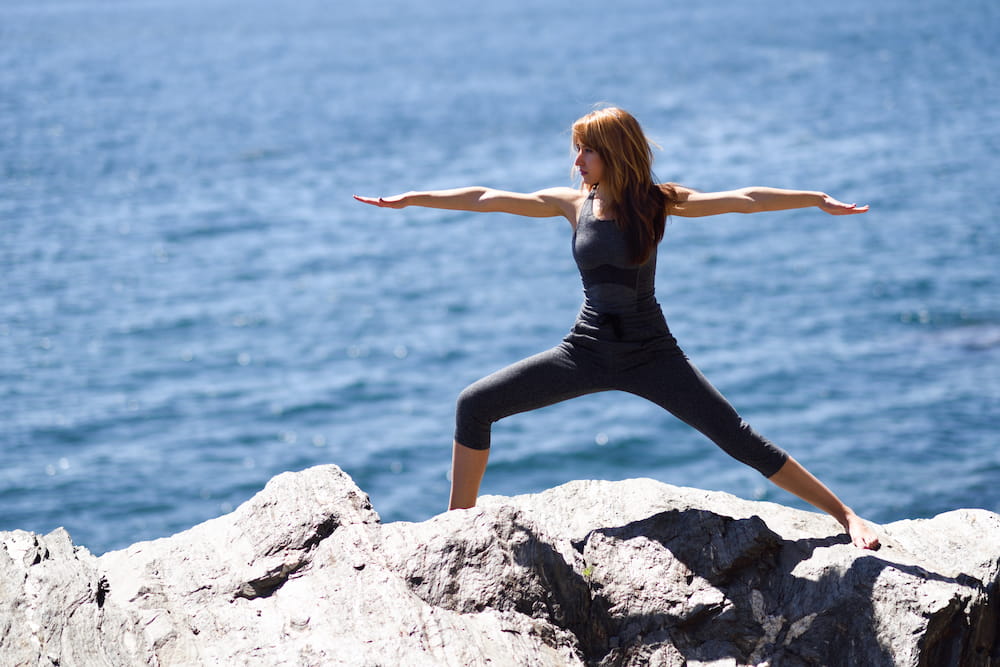
Warrior II, or Virabhadrasana II, is a powerful pose that symbolizes strength and stability, offering numerous health benefits specifically tailored for women. This pose not only enhances physical equilibrium and stamina, but it also promotes mental fortitude, embodying the warrior spirit within.
When transitioning into Warrior II, attention to alignment is key. A woman begins by standing at the top of her mat, stepping her feet apart roughly the length of one of her own legs. She turns her right foot out 90 degrees, aligning her heel with the inner arch of her left foot, her left toes angled slightly inwards for balance.
As she exhales, she bends her right knee, ensuring that it tracks over the right ankle. Her hips open to the side as she grounds through her back foot, building a strong base. Her arms then extend energetically in opposite directions, opening her chest while her gaze settles over her right fingertips. Here, she embodies a warrior, strong and focused.
Holding Warrior II pose for several breaths, a woman engages her core, toning her abdominal muscles. Her leg muscles strengthen with every breath, improving circulation and energizing the lower extremities. The open stance also encourages improved respiration, as the chest and shoulders expand, promoting better lung function.
This pose supports pelvic floor health by engaging the relevant muscles, vital for women’s wellbeing. Regular practice ensures increased stability, both physically and mentally, as Warrior II bolsters self-assurance and courage in daily life. It is a testament to the power of yoga to empower women in body, mind, and spirit.
Pose 4: Triangle Pose (Trikonasana) – Strength and Flexibility
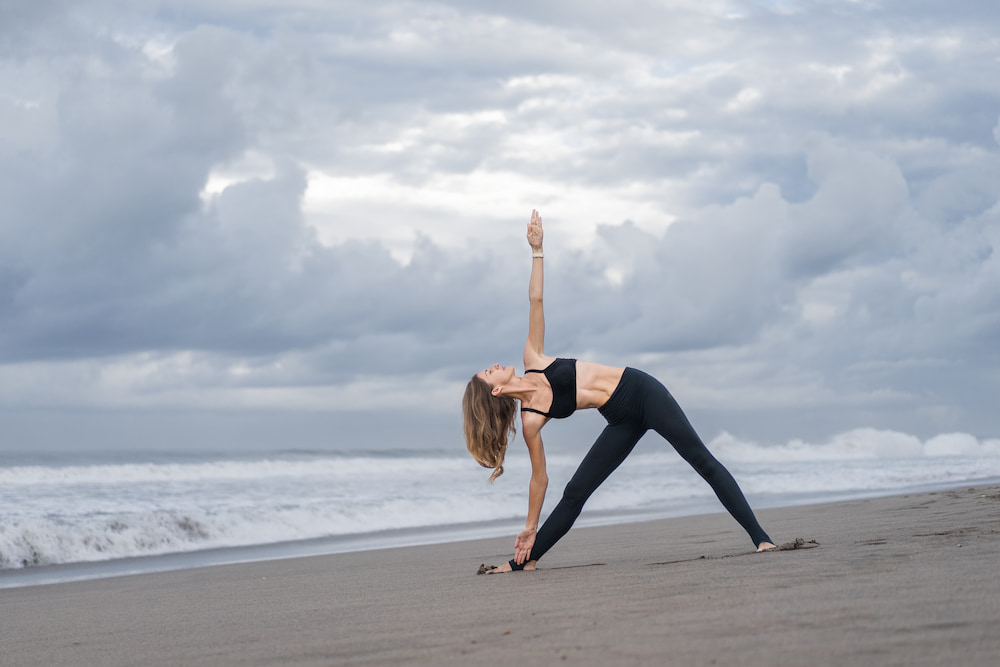
The Triangle Pose, or Trikonasana, is a classic yoga asana that offers a wealth of benefits for women’s health, emphasizing both strength and flexibility. It involves an elegant stretch of the legs, hips, spine, and chest, while simultaneously building muscle around these core areas. Here’s how one can incorporate this beneficial pose into a yoga routine.
Instructions:
- Stand Straight: Begin in a standing position with your feet about 3-4 feet apart. Turn your right foot out 90 degrees and your left foot inwards slightly.
- Extend Arms: Extend your arms out to the sides at shoulder height with palms facing down.
- Bend Sideways: Shift your left hip out to the left as you slide your right hand down your right leg, going as far as comfortable while keeping both legs straight.
- Reach and Look Up: Reach the left arm straight up towards the ceiling while turning your head to gaze at your left thumb. Ensure your body is not leaning forward or backward – the chest should remain open.
- Hold the Pose: Hold this position, breathing deeply for about 30 seconds to 1 minute. Maintain the strength of your legs and core to support your posture.
- Reverse and Repeat: To release, inhale deeply, come up to standing, reverse your feet and repeat on the other side.
Benefits:
- Enhances Stability: Trikonasana works on the leg muscles, promoting a sense of groundedness and stability.
- Spinal Flexibility: This pose encourages the twisting and elongation of the spine, which can help relieve backache.
- Flow of Digestion: The twisting motion aids in the stimulation of the digestive system, making it beneficial for gastrointestinal function.
- Stress Reduction: It can help reduce anxiety and stress by opening the chest and shoulders, areas where tension is often held.
Integrating Triangle Pose into a regular yoga practice could significantly benefit women’s health by combining the dual action of stretching and strengthening. It’s particularly advantageous for those looking to enhance their core stability and spinal mobility, contributing to overall well-being.
Pose 5: Bridge Pose (Setu Bandhasana) – Pelvic Floor Support and Relaxation
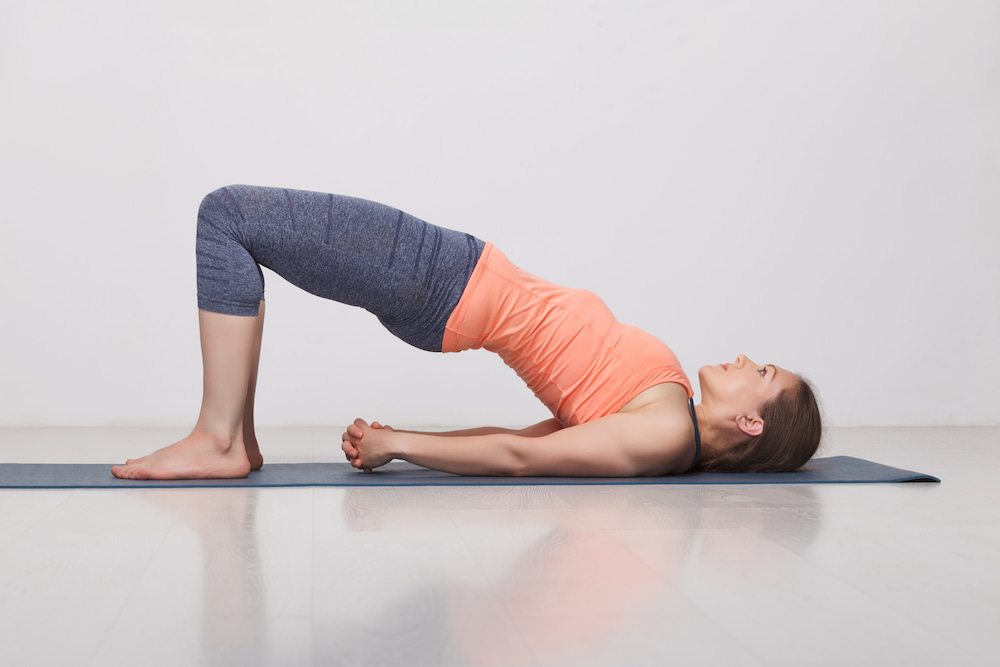
Bridge Pose, known as Setu Bandhasana in Sanskrit, is a restorative yoga posture that offers numerous benefits for women’s health, chiefly targeting the pelvic floor, the group of muscles essential for supporting internal organs and aiding in bladder and bowel function. This pose is particularly valuable for women because it helps to both strengthen and relax the pelvic floor muscles, which is crucial for postpartum recovery, menstrual cramps relief, and maintaining overall pelvic health.
Practicing Bridge Pose involves:
- Lying flat on the back with knees bent and feet planted on the ground, hip-width apart.
- Arms rest alongside the body with palms facing down.
- On an inhale, pressing the feet and arms into the floor, lifting the hips up towards the ceiling.
- Engaging the thighs to keep them parallel, refraining from splaying outwards.
- Optionally, clasping the hands under the back and extending through the arms to help open the chest.
- Holding the position for several breaths, lifting the hips higher on each inhale and feeling the pelvic floor gently engage.
Benefits of Bridge Pose include:
- Strengthening the muscles of the back, buttocks, and hamstrings alongside the pelvic floor muscles.
- Stretching the chest, neck, and spine, which can relieve stress and mild depression.
- Improving blood circulation, particularly in the lower abdomen.
- Alleviating menstrual discomfort and symptoms of menopause.
- Beneficial for high blood pressure, osteoporosis, and sinusitis.
For added support or as a gentler modification, a yoga block can be placed under the sacrum. This version supports a sustained opening for the pelvic area, allowing for further relaxation. It’s worth noting that women who are pregnant or have back injuries should approach this pose with caution and consult a healthcare provider or a qualified yoga instructor.
Breathing Techniques and Their Role in Enhancing Yoga Practices
Breathing is the essence of yoga, serving as a critical bridge between the mind and the body. Proper breathing techniques, or pranayama, can significantly influence the effectiveness of yoga practices, allowing women to optimize their health benefits. By integrating specific breathing methods, yoginis can enhance their concentration, control their energy levels, and deepen their yoga poses.
- Diaphragmatic Breathing: By encouraging full oxygen exchange, this technique reduces the heart rate and lowers blood pressure, promoting relaxation and stress reduction. It is performed by breathing deeply into the belly rather than shallow breaths from the chest.
- Ujjayi Pranayama: Also known as the “Victorious Breath,” it involves constricting the back of the throat to create a gentle hissing sound on the inhale and exhale. This practice warms the body from the inside, helping to maintain focus and syncing movement with breath—a fundamental aspect of Vinyasa yoga.
- Nadi Shodhana: Commonly known as “Alternate Nostril Breathing,” this technique calms the mind, improves focus, and balances the left and right hemispheres of the brain. By alternately breathing through one nostril at a time, it can help harmonize the body and mind, setting a serene foundation for yoga practice.
- Kapalabhati Pranayama: Characterized by a series of rapid breaths, Kapalabhati is intended to cleanse the lungs and boost energy levels. It is especially beneficial before performing poses that require stamina and vigor.
Incorporating these breathing techniques into a yoga routine helps to enhance the experience, allowing women to delve deeper into their practice, regulate their physiological responses, and achieve a more substantial mind-body connection. Mastering the art of breath control can thus elevate the physical and psychological benefits, making the practice of yoga a more profound and transformative experience.
Tailoring Yoga to Different Phases of a Woman’s Life
Yoga, as a holistic approach to health and wellness, offers great flexibility to adapt to the changing needs of a woman’s body throughout her life. By adjusting yoga practices, women can nurture their physical and emotional wellbeing at each stage of life.
- Menstruation: During this phase, women may experience discomfort or emotional stress. Gentle poses like Supta Baddha Konasana (Reclining Bound Angle Pose) can alleviate cramps and soothe the nervous system. Balasana (Child’s Pose) is another supportive pose, promoting relaxation and easing tension.
- Pregnancy: As the body adapts to accommodate a growing baby, yoga can prove invaluable. Tailoring poses to the trimester is key. For example, Marjaryasana (Cat Pose) into Bitilasana (Cow Pose) encourages spinal flexibility, beneficial during the first trimester. Later, Viparita Karani (Legs-Up-the-Wall Pose) can aid in reducing swelling in the legs and feet.
- Postpartum: Postnatal yoga focuses on regaining strength and stability, especially in the abdominal and pelvic floor muscles. Pelvic Tilts and modified core exercises can lay a foundation for recovery. Understanding that rest is crucial, poses like Savasana (Corpse Pose) with supportive props can be highly restorative.
- Perimenopause and Menopause: To counteract hormonal fluctuations and related symptoms, cooling and restorative poses like Supta Virasana (Reclining Hero Pose) can be helpful. Weight-bearing poses like Tadasana (Mountain Pose) are important for maintaining bone density during these years.
By sensitively adapting yoga practice to accommodate hormonal cycles, pregnancy, and menopausal changes, women can maintain balance and wellbeing throughout the various stages of life. It’s recommended to consult with yoga instructors specialized in women’s health to ensure the practice is safe and beneficial.
Common Concerns: Modifications for Pregnancy and Menstruation
When incorporating yoga into a female wellness routine, understanding and accommodating the unique physiological experiences of pregnancy and menstruation is crucial. During these times, women may confront concerns around comfort and safety while attempting various yoga poses.
For pregnant women, the body undergoes significant changes, which include a shift in the center of gravity and additional stress on the musculoskeletal system. Certain yoga poses can be modified to support these changes:
- Standing poses, like the mountain pose, provide grounding but should be performed with feet hip-distance apart for better balance.
- Twists must be open rather than closed, ensuring there’s no compression of the belly.
- Backbends should be gentle, and support such as a bolster can be utilized to avoid overextension.
As for menstruation, while some practitioners recommend a gentle approach to yoga, it’s essential to listen to the body and reduce intensity if needed:
- Inversions such as headstands or shoulder stands are often controversial during menstruation; a gentler alternative can be the legs-up-the-wall pose.
- Vigorous practices should be replaced with restorative poses and deep breathing to encourage relaxation and ease discomfort.
It is vital that women modify yoga poses during these times to maintain safety and comfort. Consulting with a yoga instructor knowledgeable in prenatal yoga or women’s health can provide additional customized guidance. It is always encouraged to honor the body’s needs and limitations, ensuring that the practice of yoga continues to serve as a nurturing and beneficial tool throughout all stages of a woman’s life.
Integrating Yoga Into Your Daily Routine: Tips and Tricks
Integrating yoga into one’s daily routine can seem challenging amidst the hustle of life, yet with mindfulness and proper planning, it can become an enriching habit. Women seeking to enhance their health through yoga can apply these strategies:
- Establish a Set Time: Choose a specific time each day for your yoga practice. Early morning can be ideal as it sets a peaceful tone for the day, but any consistent time slot works if it fits your schedule.
- Begin with Short Sessions: Initially, aim for short, 10-15 minute sessions. This way, yoga does not become overwhelming. As the practice becomes a habit, you can gradually extend the duration.
- Create a Comfortable Space: Dedicate a comfortable and inspiring space in your home for yoga. A quiet corner with a yoga mat, and perhaps some calming decor or soothing music, can make a significant difference.
- Mix It Up: Incorporate different yoga poses or sequences to keep the practice interesting. This not only enhances physical benefits but also maintains mental engagement.
- Incorporate into Daily Activities: Find opportunities to incorporate yoga into daily activities. For instance, perform a few stretches while waiting for the kettle to boil or practice balance by standing on one foot while brushing your teeth.
- Set Realistic Goals: Establish attainable goals, such as mastering a new pose or improving flexibility. Achieving these can provide a sense of accomplishment and motivate continued practice.
- Use Online Resources: Take advantage of the plethora of online tutorials, apps, and videos available for guidance and variety in your practice.
- Stay Consistent: Consistency is key. Even on busy days, a few minutes of yoga is better than none. Consistent practice improves health and slowly unravels the deeper benefits of yoga.
Incorporating these tips into one’s lifestyle can assist in seamlessly blending yoga into daily life, thus fostering better health and well-being for women who practice it.
Embracing Yoga for a Healthier, Happier You
Yoga, an ancient practice with enduring relevance, has proven to be an invaluable asset for women’s health. It transcends mere physical exercises, emerging as a holistic approach to wellness that harmonizes the mind, body, and spirit. The integration of yoga into daily routines offers a gentle yet effective means to address various health concerns that often afflict women, ranging from hormonal imbalances to stress-related disorders.
The beauty of yoga lies in its accessibility and adaptability. With poses ranging from simple to complex, women of all ages and fitness levels can discover routines that resonate with their individual needs. Consistent practice of the essential poses not only improves flexibility, balance, and strength but also fosters a sense of inner peace and emotional resilience.
Yet, it is the preventative aspect of yoga that is particularly compelling. By enhancing immune function, promoting heart health, and supporting mental well-being, yoga acts as a preventive measure against common health issues. Moreover, the emphasis on mindful breathing and awareness cultivates a deeper connection with the self, empowering women to make proactive choices concerning their health.
In summary, embracing yoga is synonymous with embracing a healthier, happier version of oneself. It is an investment in one’s well-being that yields dividends across all facets of life. Women, by incorporating these five essential yoga poses into their regimen, can embark on a transformative journey towards holistic health—a testament to the timeless wisdom embedded within this ancient practice.




